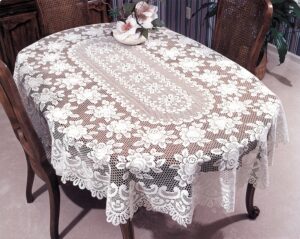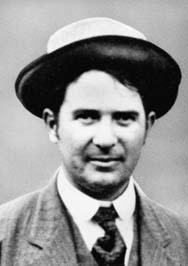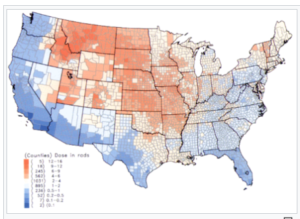Monthly Archives: November 2023

 Tablecloths…usually used to dress up a table, often for a holiday dinner these days, were not always used for that purpose. Children wiping their mouths on tablecloths isn’t generally acceptable at the dinner table these days, but that was their original use! It was like a community napkin. Guests were meant to wipe off their hands and face on a tablecloth after a messy feast, and not do this would be considered bad table manners! These days it’s pretty much the opposite. The idea is to try not to “spill” or otherwise mess up the tablecloth.
Tablecloths…usually used to dress up a table, often for a holiday dinner these days, were not always used for that purpose. Children wiping their mouths on tablecloths isn’t generally acceptable at the dinner table these days, but that was their original use! It was like a community napkin. Guests were meant to wipe off their hands and face on a tablecloth after a messy feast, and not do this would be considered bad table manners! These days it’s pretty much the opposite. The idea is to try not to “spill” or otherwise mess up the tablecloth.
While original tablecloths were usually white…another odd idea, considering the practice of wiping one’s mouth and hands with the cloth, today’s version is often colorful, and decorative to match the holiday currently being celebrated. The most common shapes for tablecloths are round, square, oval, and oblong, or rectangular, corresponding to the most common table shapes. Tablecloths usually have an overhang, referred to as the “drop” of about 6 to 15 inches on each side of the table. The shorter drop is usually for casual dining and a longer drop for more formal occasions. Sometimes a floor-length cloth is used. Custom-made tablecloths are also available, and some people choose to make their own.
Some tablecloths are just decorative, and often used on a wooden table to help protect the table from scratches and stains. Others are designed to be spread on a dining table before laying out tableware and food. In formal settings, tablecloths are designed as part of an overall table setting, with coordinating napkins, placemats, or other decorative pieces, and in very formal settings the might also be “runners” overhanging the table at two ends only and “table protectors” which provide a padded layer under a normal tablecloth.
Today’s more casual, and less expensive tablecloths are typically made of cotton, and some have a poly-cotton blend, or a PVC-coated material that can be wiped clean. Of course, any material works, and some people use delicate fabrics like embroidered silk. Today, the biggest consideration, at least in casual settings, is ease of cleanup, so the material might be chosen for its ability to fight stains.
Of course, one more use for a tablecloth, was in shows, where the tablecloth is quickly pulled from under a set table full of food. The idea is to pull it quickly enough to leave the table’s contents in place while pulling the cloth from under them. This trick relies on inertia. It is known as a tablecloth pull or a tablecloth yank. Unless 
 you are prepared for the cleanup following such a trick, I wouldn’t exactly recommend trying that one. I think most of us knew most of these uses, but maybe not the original use. Nevertheless, now you know. I would be careful using the tablecloth in that way at your next family dinner, however. It might not be appreciated.
you are prepared for the cleanup following such a trick, I wouldn’t exactly recommend trying that one. I think most of us knew most of these uses, but maybe not the original use. Nevertheless, now you know. I would be careful using the tablecloth in that way at your next family dinner, however. It might not be appreciated.
 Cheerleaders are a staple of the sporting scene. Often seen at football games, they are also at other sporting event. Still, football is the main one, but how did cheerleading get started. It wasn’t some sort of organized decision by coaches or schools, but rather it was a spontaneous action that turned into something we all know about and enjoy watching, and something that many girls (and guys too) dream about becoming.
Cheerleaders are a staple of the sporting scene. Often seen at football games, they are also at other sporting event. Still, football is the main one, but how did cheerleading get started. It wasn’t some sort of organized decision by coaches or schools, but rather it was a spontaneous action that turned into something we all know about and enjoy watching, and something that many girls (and guys too) dream about becoming.
November 2, 1898, is officially recognized as the “birth of cheerleading.” It all started at the University of Minnesota, when student Johnny Campbell directed fans in cheering on the Golden Gophers football team, cheering “Rah, Rah, Rah! Ski-u-mah, Hoo-Rah! Hoo-Rah! Varsity! Varsity! Varsity, Minn-e-So-Tah!” That made Campbell the very first cheerleader. The whole thing was so well received, that soon after that, the University of Minnesota organized a “yell leader” squad of six male students, who still use Campbell’s original cheer today. Good thing the name “yell squad” didn’t take!! Prior to Campbell’s date with history, cheering existed, of course, just not in this new form. Prior to November 2, 1898, the fans  cheered at the game…meaning they yelled, screamed, and jumped up and down. Fans that would start cheers in the stands were called “cheerleaders,” on an unofficial basis, but they really weren’t officially leaders, just initiators. That day however, Campbell made history when he jumped down in front of the fans to lead an organized cheer.
cheered at the game…meaning they yelled, screamed, and jumped up and down. Fans that would start cheers in the stands were called “cheerleaders,” on an unofficial basis, but they really weren’t officially leaders, just initiators. That day however, Campbell made history when he jumped down in front of the fans to lead an organized cheer.
I don’t think everyone realizes just how important the cheerleaders are. Sometimes, when the game seems lost, the cheerleaders are solely responsible for lifting the spirits of fans and players alike. Sometimes, it encourages the players to press on, and other times it just tells them, “We love you anyway.” Today, most high school, college, and  professional sports teams have cheerleaders, with a few notable exceptions. The Cleveland Browns famously or infamously do not and never have had cheerleaders, and for this year neither do the Bills, Bears, Chargers, Giants, Packers, or Steelers. The Dallas Cowboy cheerleaders are probably one of the most famous of cheerleading organizations and for them it is a seriously big production. Tryouts are rigorous and highly competitive. The cheerleading squads these days are bigger than they used to be too. There are also competitions that are held each year too. It is now considered a sport in most schools. In fact, in the colleges, the cheerleaders have to sign a contract to be there and plan to stay with it for the entire season. Usually, there are scholarships attached to cheerleading, and the practice session and games are mandatory, with strict rules on allowed absences. Cheerleaders are an important aspect of college sports, and the squads must be dedicated. Cheerleading has come a long way since 1898, and I think most people would agree, that it’s been a good thing.
professional sports teams have cheerleaders, with a few notable exceptions. The Cleveland Browns famously or infamously do not and never have had cheerleaders, and for this year neither do the Bills, Bears, Chargers, Giants, Packers, or Steelers. The Dallas Cowboy cheerleaders are probably one of the most famous of cheerleading organizations and for them it is a seriously big production. Tryouts are rigorous and highly competitive. The cheerleading squads these days are bigger than they used to be too. There are also competitions that are held each year too. It is now considered a sport in most schools. In fact, in the colleges, the cheerleaders have to sign a contract to be there and plan to stay with it for the entire season. Usually, there are scholarships attached to cheerleading, and the practice session and games are mandatory, with strict rules on allowed absences. Cheerleaders are an important aspect of college sports, and the squads must be dedicated. Cheerleading has come a long way since 1898, and I think most people would agree, that it’s been a good thing.

 Our government has been known, in its history, to do some things that really were underhanded, and in some cases horrific. The “need” for nuclear bombs naturally facilitated the need for nuclear testing. I think everyone knows that would had to have happened, but on November 1, 1951, the US Army conducted nuclear tests in the Nevada desert that included a “diabolical exercise in which 6500 US Army troops were exposed to the effects of a nearby nuclear detonation and its associated radiation.” When I read that, I was furious. They knew what they were doing, and they did it as an experiment…just to see what would happen to those poor men.
Our government has been known, in its history, to do some things that really were underhanded, and in some cases horrific. The “need” for nuclear bombs naturally facilitated the need for nuclear testing. I think everyone knows that would had to have happened, but on November 1, 1951, the US Army conducted nuclear tests in the Nevada desert that included a “diabolical exercise in which 6500 US Army troops were exposed to the effects of a nearby nuclear detonation and its associated radiation.” When I read that, I was furious. They knew what they were doing, and they did it as an experiment…just to see what would happen to those poor men.
It was called Operation Buster–Jangle. The US Army conducted a series of 7 nuclear tests, that included the November 1st test. In that involuntary one test, the 6500 troops, were dug in foxholes and trenches only 6 miles from an air burst nuclear bomb of 21 kilotons yield. That is about the size of the Nagasaki bomb!! After the soldiers felt the hot nuclear wind blast over them, the wind deposited desert dust in choking clouds upon the men. Then, the soldiers were ordered to get up and march across the blast site to within 900 meters (a little over ½ a mile) of the nuclear “ground zero.” That is incredibly close, and those men were exposed.
The damage done to those men was not well documented, but the US Government later passed the 1990 Radiation Exposure Compensation Act (RECA) to compensate the military veterans exposed to nuclear testing in the 1950’s. The passing of that act is implied acknowledgment of the responsibility of the US government in long term health problems experienced by those troops…without actually placing the blame, and therefore opening the government up to future lawsuits. Basically, the men, were they still alive, or their families, if not, 
 could theoretically be compensated for their losses. Of course, as many of us have seen with these kinds of cases, the process is very slow, the burden of proof for the men trying to receive compensation is heavy, and the final payout is usually quite low. RECA has awarded over $2.4 billion in benefits to more than 37,000 claimants since its inception in 1990. Still, that’s a small price to pay for the destruction of so many lives.
could theoretically be compensated for their losses. Of course, as many of us have seen with these kinds of cases, the process is very slow, the burden of proof for the men trying to receive compensation is heavy, and the final payout is usually quite low. RECA has awarded over $2.4 billion in benefits to more than 37,000 claimants since its inception in 1990. Still, that’s a small price to pay for the destruction of so many lives.

